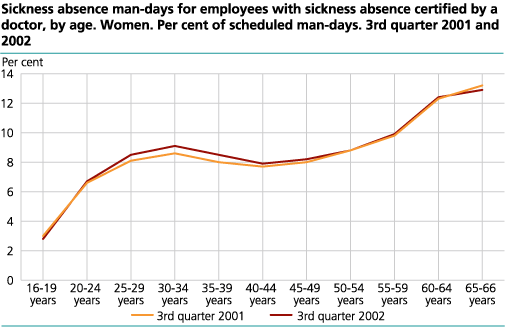Content
Published:
This is an archived release.
Increase in sickness absence
The sickness absence rate increased from 6.8 to 7.1 from the third quarter of 2001 to the third quarter of 2002. The absence rate in health and social work had a small decrease, while the absence in manufacturing increased more than the average.
This article refers to sickness absence certified by a doctor unless something else is stated. In about two months time we will also know the self-certified absence and thus total sickness absence rate for the third quarter of 2002.
Decrease in health and social work
Health and social work, which had a high level of sickness absence (9.0 per cent), showed a decrease by 0.1 percentage points. Financial intermediation had a decrease in the sickness absence rate from 4.9 in the third quarter of 2001 to 4.8 in the third quarter of 2002.
Strongest increase in manufacturing and business activities and real estate
Manufacturing, construction and business activities and real estate had a stronger increase in the sickness absence than the average. The sickness absence rate in manufacturing increased from 7.2 to 7.7 [corrected 13.01.03], the absence in construction from 7.0 to 7.5, and business activities and real estate from 5.3 to 5.8.
The main industries manufacturing and business activities and real estate are both pools of smaller industries with considerable variations in levels and developments in the sickness absence. Among the largest industries in manufacturing, wood products and other non-metallic mineral products had respectively no growth and a 0.1 percentage points decrease in the absence rate. Publishing and rubber and plastic products had the strongest increase, with 0.8 and 0.9 percentage points respectively.
Decrease in the north
The sickness absence rate in Finnmark decreased for the second consecutive quarter, from 8.8 in the third quarter of 2001 to 8.7 in the third quarter of 2002. Troms also had a decrease in the absence rate of 0.1 percentage points in the same period, while Nordland had no growth. Especially women had a positive development in the north. The development in the north is related to a decrease in the absence rate in health and social work in this part of the country. The effect of this decrease is considerable because these three counties have a larger share of its employees in health and social work than the average of Norway. Nevertheless, Nordland, Troms and Finnmark still have among the highest sickness absence rates in Norway.
The sickness absence in Østfold, Vestfold and Aust-Agder had a higher increase than the average from the third quarter of 2001 to the third quarter of 2002. All these counties have a high share of their employees in manufacturing and construction, industries with a higher increase in the sickness absence than the average. Østfold also had an increase in the absence rate for Health and social work in contrast to the country average. Only Finnmark has a higher level of sickness absence than Østfold this time.
Strongest increase among women aged 25-39
Among women the increase in sickness absence was strongest in the group aged 25-39, with an increase of 0.5 percentage points from the third quarter 2001 to the third quarter 2002. The strongest increase for men was in the group aged 30-44. The sickness absence rate for men is still increasing with age. Women reach a temporary peak in the age of 30-34. The third quarter of 2002 the sickness absence rate for this group was 9.1, and women do not have a higher absence level before the age of 55-59 (9.9).
Sickness absence by duration
The first quarter 2002 35.2 per cent of the sickness absence man-days were connected to sickness absence cases lasting more than six months (26 weeks). These figures include the self-certified sickness absence. Construction, domestic trade, hotels and restaurants had a relatively large share of their sickness absence connected to long-term sickness absence cases, 39.5 and 39.2 per cent respectively. Financial intermediation and public administration had a relatively low share of their absence connected to absence of more than 26 weeks, 29.5 and 31.9 per cent respectively.
Changes in the sickness absence statistics
The statistics include all sickness absence certified by a doctor while previous releases have excluded sickness absence certified by a doctor shorter than four days. This change gives a rise in the sickness absence rate by approximately 0.1 percentage points for most groups.
The tables for sickness absence by duration are also changed. The new duration tables contain sickness absence man - days for terminated sickness absence cases, and not ongoing cases as in the previous releases. The statistics now also contain self-certified absence. To be sure that the sickness absence case really is terminated in a specific quarter, we wait two quarters to make sure the absence is not prolonged. This slows down the production time of the duration tables with two quarters but makes the statistics more accurate.
Sickness absence statistics in Statbank Norway
Statbank Norway is a service containing detailed statistics on the Internet. The English version will be online soon and will contain sickness absence statistics by sex, age, industry and county of residence.
The sickness absence statistics are produced in cooperation with the National Insurance Administration (RTV).
Tables
The statistics is published with Sickness absence.

